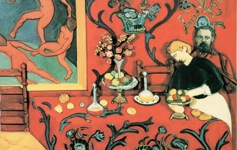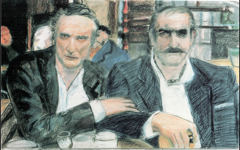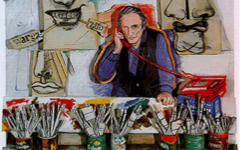Larry Rivers’ A Vanished World: Gilbert and Garbo 1 (1994)

Rivers, A Vanished World: Gilbert and Garbo 1 (1994) Oil on canvas mounted on foamcoare. Private Collection
Click image to enlarge.
In Larry Rivers' copy of a still from the 1926 film Flesh and the Devil (starring Greta Garbo and John Gilbert) he has used the act of kissing to symbolize the act of painting. Indeed even the title of the film suggests two levels of reality: Gilbert as the Devil on one level; Garbo as Flesh on the other. Many artists over the centuries have identified with the devil, as Rivers does here. He is the Devil kissing/creating his painting of the ultimate beauty, Greta Garbo, using love as a creative force.

L to R: Original detail of Gilbert from the film still Rivers used; Detail of Gilbert in Rivers' A Vanished World; Photographic detail of Rivers in profile.
Click image to enlarge.
How do we know? Rivers took care to alter Gilbert's profile and where he did so it now matches his own. Compare Gilberts nose in the original film still (far left) to Rivers' copy of it (center) and a photo of his own proboscis (near left.) The nostril is lengthened to match his own and the line of the nose becomes curved for the same reason.
See conclusion below
There are many ways an artist can indicate that he is present in the picture painting his "painting". Kissing, which Rivers uses, is an extension of touch, a very common method in Renaissance art. It also suggests through the theme of the loving couple that the artwork (here Garbo) is a reflection of the artist (Gilbert). Another common theme that Rivers uses, in posing as the devil that Gilbert played, is that of the artist as evil. We will soon add that Theme to demonstrate how often artists depict themselves as Satan and other demonic types. Artists equate evil with chaos, an essential element of the creative mind because only by the chance encounter of unrelated forms, powered by chaos, can new forms emerge.
More Works by Rivers
Notes:
Original Publication Date on EPPH: 16 Jul 2011. | Updated: 0. © Simon Abrahams. Articles on this site are the copyright of Simon Abrahams. To use copyrighted material in print or other media for purposes beyond 'fair use', you must obtain permission from the copyright owner. Websites may link to this page without permission (please do) but may not reproduce the material on their own site without crediting Simon Abrahams and EPPH.



